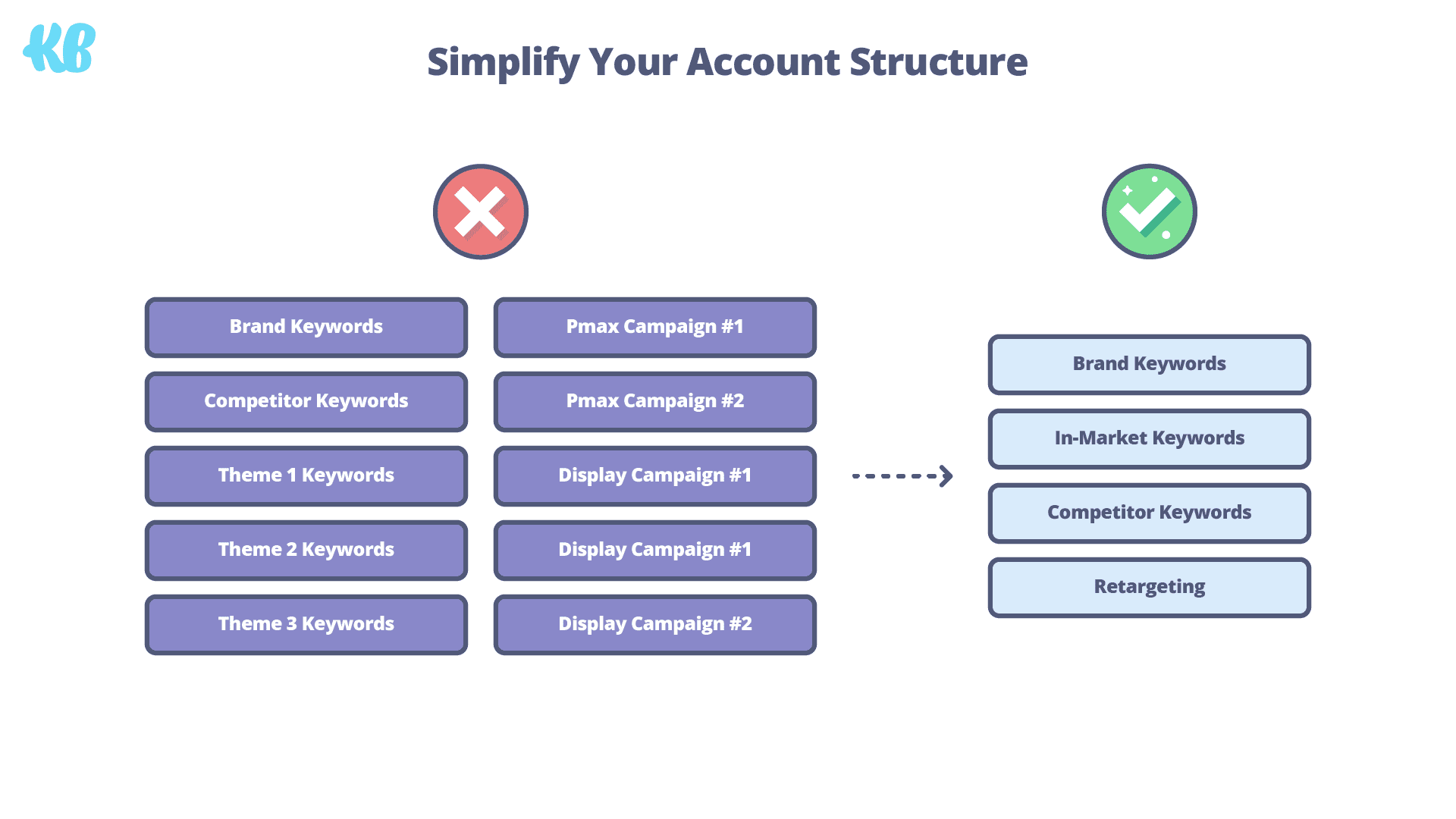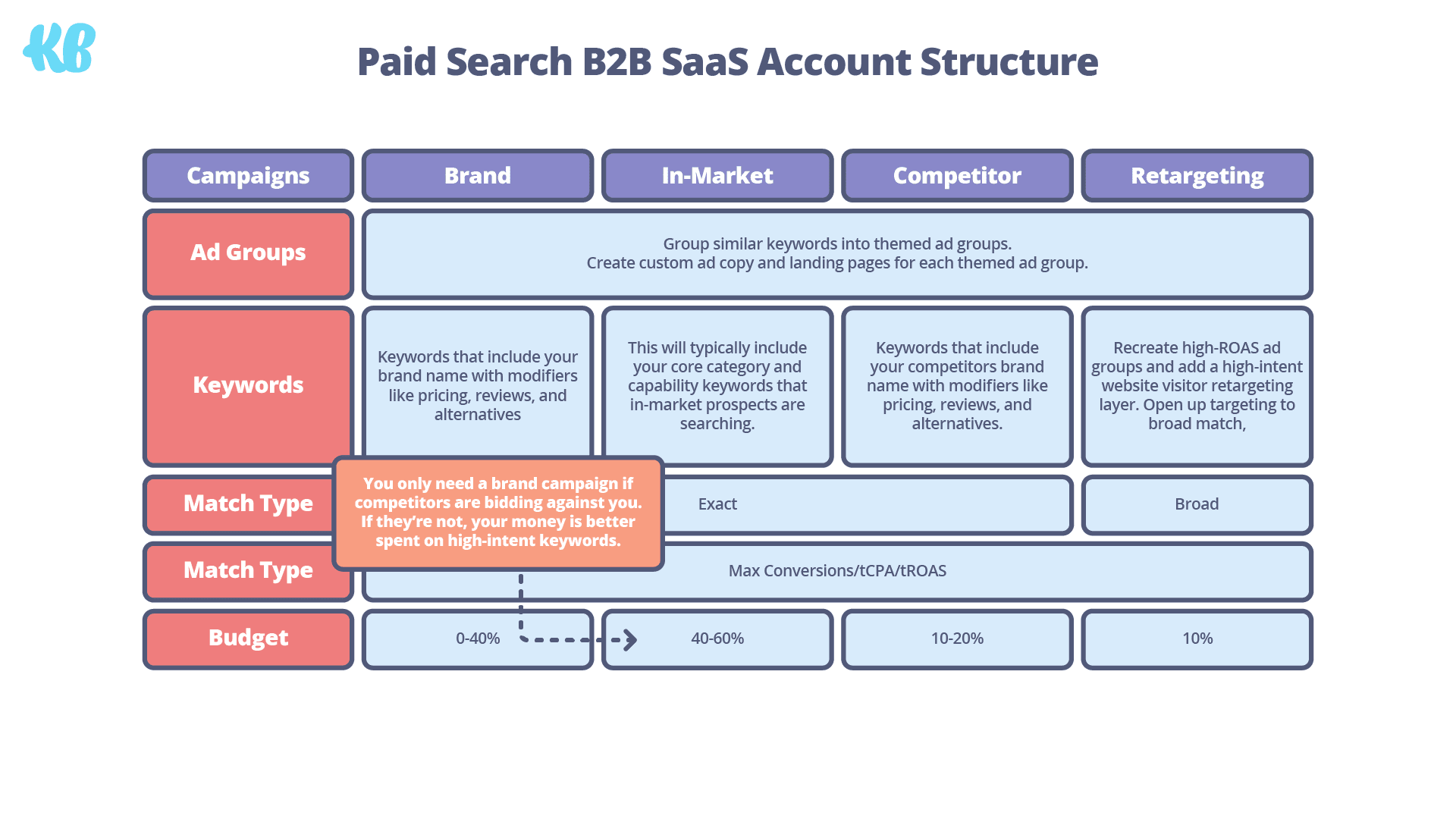Leverage paid search for what it’s best at and finally stop paid search CAC spiraling out of control.
Ingredients
Instructions
Stop Optimizing Paid Search For Demand Generation
Here’s where most B2Bs go wrong with paid search:
- Running too many non-search campaigns
- Targeting too many low-intent keywords
- Poor bid strategy and conversion action choices
This leads to overly complex account structures that increase CAC (the cost to acquire a customer) and don’t deliver sustainable ROI.
Not good.
Pmax, Demand Gen, YouTube, and Display campaigns can work (with a lot of effort and data).
Pro B2Bs Optimize Paid Search For Demand Capture
Google Ads works best when it’s used for demand capture.
Trying to use it for anything else will hemorrhage your ad spend—which is better spent on demand generation channels with higher ROI (like LinkedIn Ads).
B2Bs should simplify their account structure to exclusively target in-market keywords:

The simplified account structure has just 4 campaigns:
- Brand Keywords
- In-Market Keywords
- Competitor Keywords
- Retargeting
Yes, we have an In-Market Keywords campaign for non-brand keywords. But, you can technically categorize all 4 campaigns as in-market.
People searching for yours or your competitors’ brand name are likely in-market for your services.
The Retargeting campaign targets users who have already shown intent via a website visit, form submission, or similar.
The Exact Google Ads Account Structure KlientBoost Uses
You have the four campaigns you need—let's optimize them.
The table below shows the ad groups, landing pages, keywords, match types, bid strategies, and budgets for each campaign:

Ad groups
We find STAGs work best for most B2Bs and use them in all our campaigns.
STAG (Single Theme Ad Group): an ad group with similar theme (related) keywords. For example, we have ad groups with keywords for each service area.
- Google Ads Agency
- Meta Ads Agency
- LinkedIn Ads Agency
For each ad group, create custom copy and landing pages to maximize CTR, conversion rate, and ultimately pipeline and revenue.
Don’t stress if you don’t have the resources to create as many landing pages as you need. Use your home page to start, then build new landing pages in priority order based on what’s driving the most demos, pipeline or revenue.
80:20 baby 😉
Keyword Targeting
Choose variations of the brand name for your Brand and Competitor ad group keywords as follows:
- [brand name] pricing
- [brand name] alternatives
- [brand name] reviews
Don’t include any low-intent variations with modifiers such as login, careers, jobs, etc.
Your In-Market campaign will include a blend of category and capability keywords. The fundamental rule here is to only choose keywords that signal buying intent.
(Read the How to Choose Profitable Google Ads Keywords recipe to learn more about category and capability keywords).
Your retargeting campaign will target keywords from your best performing ad groups.
You’ll add a high-intent retargeting audience layer to these ad groups—such as pricing and demo form page visits—and open up targeting to broad match.
The high-intent retargeting audience acts as a protective barrier against the broad match tendency to display your ads for irrelevant search terms.
Exact Match vs Broad Match
Your Google rep will beg you to use broad match on all your campaigns (and probably Pmax too).
Ignore them.
It will eat your budget and send you s*** leads that don’t convert (you’ve been warned) ⚠️
Bidding Strategies
In most cases, the Max Conversions bid strategy is your safest bet.
It’ll aim to find the maximum number of conversions possible within your allocated budget.
If you’re getting close to maxing out search impression share—consider switching to a tROAS or tCPA bid strategy.
This will allow you to drive down CAC and maximize ROI when you’ve reached the point of diminishing returns.
Don’t be afraid to test other bid strategies impact on performance too. Every business responds differently to Google Ads.
Make sure you use the experiments feature in Google Ads to test bid strategies against each other within the same market conditions. This ensures a fair test—results aren’t skewed by unforeseen seasonality or market changes.
Budget Allocation
Budget allocation varies from company to company—you’ll need to move things around to find out what works.
Brand Keywords (0–40%)
Allocate 0–40% of your budget to Brand Keywords campaigns—the more competitors bidding against your brand name, the more budget you’ll need.
It’s always worth running incrementality tests on brand keywords to see if there’s a net decrease when they’re switched off. If not, you can allocate that spend to other high-performing campaigns.
In-Market Keywords (40–60%)
Allocate 40–60% of your budget to In-Market Keywords campaigns. For B2Bs with low competition, you can push this as high as 80%.
Competitor Keywords (10–20%)
Allocate 10–20% of your budget to Competitor Keywords campaigns. How much will depend on how well your competitor keywords convert. If they convert well, allocate more budget.
Retargeting (~10%)
Finally, allocate ~10% of your budget to Retargeting campaigns. These are typically much lower volume and don’t require as much spend.
Time To Cook
You have all the ingredients for higher ROI Google Ads campaigns. Now, go cook up some pipeline.
Once the new structure is in place, don’t make any major changes for 2–4 weeks—opt for the longer end if you have a lengthy sales cycle.
The only optimization you need to make in this period is search term cleanup to cut any unrelated search terms.
After this period, you should see inbound demos—and some pipeline (MQLs and SQLs).
Subscribe to our weekly newsletter for tips so good that we might put ourselves out of business.
You can now start reallocating budgets, pausing keywords, and experimenting with new bid strategies based on what’s driving performance.
